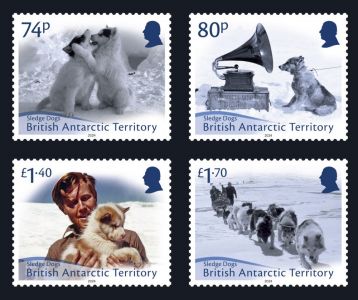
The British Antarctic Survey (BAS) used sledge dogs to transport field parties and support scientific work in Antarctica from 1945 to 1994. The first dogs were imported from Labrador, Canada in 1945 as part of Operation Tabarin, a secret wartime expedition. Additional dogs were brought in from Greenland in 1954 and 1961.
In the 1960s and 1970s, dogs were gradually replaced by mechanised transport, such as skidoos. A small number of dogs were kept at Rothera Research Station in the 1980s and 1990s for recreational purposes. The dogs were well looked after and gave station personnel the chance to get a feel for what the earlier explorers and scientists would have experienced. The dogs were also considered to be good for morale, which is important in an environment where people are away from home for periods of over two years. There was considerable resistance from station personnel when the legislation for the removal of the dogs was put in place.
In 1994, the last 14 dogs were removed from Rothera under the terms of the Antarctic Treaty Environmental Protocol. The ban was due to concerns that the dogs could introduce diseases and escape to worry wildlife. It was also thought to be inconsistent for the Protocol to have strict controls on the introduction of non-native species, but at the same time allow huskies to be bred and used in Antarctica.
To mark the end of the era, the dogs spent the last season doing what they did best, pulling a sledge as a working team in support of a surveying project on Alexander Island.
74p - Two months old puppies photographed by David George during the 1954/1955 season.
80p - Herbert Ponting was the official photographer and cinematographer for Captain Robert Falcon Scott's Terra Nova expedition 1910 – 1913. Here he photographed a dog called Chris as it looks into the horn of a gramophone which is playing a record.
£1.40 - This photograph by David George shows a close-up view of Norman Leppard and pup at Hope Bay during the 1955/1956 season. Norman Leppard’s career encompassed the Land Registry, Ordnance Survey, Antarctica and the Coal Board, all aspects of geodesy in Military Survey, a further career with Geo-UK Ltd and close involvement with the RICS (Royal Institution of Chartered Surveyors). He was one of the stalwarts of the survey community in UK until a road accident sadly claimed his life and that of his wife Dinah on 13 May 1998.
In 1953 he became a surveyor with the Falkland Islands Dependency Surveys (FIDS), the forerunner of British Antarctic Survey, and spent several eventful seasons in the Antarctic. He looked back on this time with great pride and affection and, as a result of his contribution, the Leppard Glacier (65°57'S, 62°57') in Graham Land was named after him and he was awarded the Polar Medal.
£1.70 - A sledge party leaving Base D, Hope Bay, with the buildings just visible in the background. It was photographed by PB Thompson during the 1956/1957 season.
FDC - Sledge dog, “Vida” photographed by Herbert Ponting in 1911 during the Terra Nova Expedition.
|
Technical Details |
|
|
Designer |
Bee Design |
|
Photography |
74p, £1.40, £1.70 - Courtesy of the BAS Archives 80p, FDC - SPRI |
|
Printer |
Cartor Security Printing |
|
Process |
Lithography |
|
Stamp Size |
38 x 30.6mm |
|
Perforation |
13 ¼ x 13 per 2cms |
|
Sheet Layout |
10 |
|
Release date |
15 – 20th December 2024 |
|
Production Co-ordination |
Creative Direction (Worldwide) Ltd |
